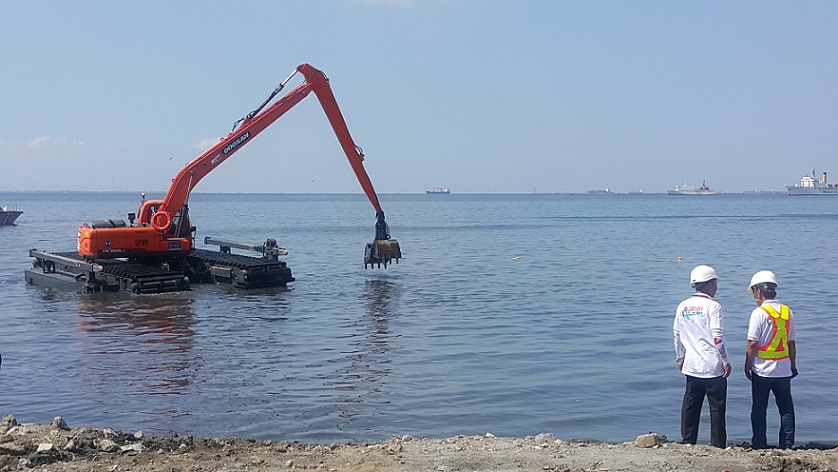A different kind of battle is now being waged at Manila Bay.
Instead of American warships that sunk the Spanish fleet 120 years ago in the 1898 Battle of Manila Bay, dredging equipment are battling a more destructive enemy – pollution and decay caused by human abuse and neglect.

Public works personnel oversee the desilting operations at the Manila Bay.
On March 5, the departments of Environment (DENR) and of Public Works (DPWH) started cleaning up Manila Bay, which has become a huge depository of waste accumulated through the years. Fecal coliform bacteria levels recorded by the DENR early this year reached 333 million MPN (most probable number) per 100 milliliters, way above the safe level of 100 MPN/100 ml.
DENR Secretary Roy Cimatu said the goal of the “Battle for Manila Bay” is to reduce coliform levels in Manila Bay to less than 270 MPN/100 ml by December.
A desilting operation dubbed “DPWH Sagip Manila Bay” was launched to clean the 1.5-kilometer stretch between the Manila Yacht Club breakwater to the US Embassy.
“We will clean this area while other areas will also be cleaned. [The trash] we get here is from different tributaries. There are some from Bulacan, from Pampanga, even from Las Piñas, that reach this area,” DPWH Engineer Francis Nuñez said.
“We clean this by moving outward [from Manila Bay], onto the tributaries,” he added.
The Manila Bay has a 190-kilometer coastline. It is bounded by Cavite and Metro Manila on the east, Bulacan and Pampanga on the north, and Bataan on the west and northwest. The southern part of the bay opens to the South China Sea.
Nuñez is aware of the enormous work that needs to be done. The agency’s silt excavators collect “around 70 percent of mire and around 30 percent garbage, including rubber tires.”
Collected soil samples are examined because, considering the soil’s dark color, it “could be contaminated.”
After only a week of dredging, the coliform bacteria levels have gone down although the water is still unsafe. Swimming remains prohibited.

Swimming is still prohibited on Manila Bay
Eleven years late
This drive to clean Manila Bay is 11 years late.
The Supreme Court, acting on a petition filed by concerned residents, on Dec. 18, 2008 ordered the DENR and other government agencies “to clean up, rehabilitate and preserve Manila Bay in their different capacities.”
Other government agencies ordered to help out included the Metropolitan Manila Development Authority, the Departments of Education, Health, Agriculture, Public Works and Highways and Budget and Management, the Philippine Coast Guard, the Philippine National Police Maritime Group, the Philippine Ports Authority and the Department of the Interior and Local Government.
Tracing the deterioration of Manila Bay
In an article in the Philippine Star, Marcos administration economic planner Gerardo P. Sicat traced the beginnings of Manila Bay’s deterioration to the liberation of Manila by the Americans from the Japanese occupying forces in 1945.
He said American military bombardment and the destruction of Manila necessitated massive post-war rehabilitation efforts that triggered the influx of people from the provinces. This resulted to an unbalanced development.
“After the reconstruction boom of the immediate postwar period came the development of industries replacing old services and installing new ones. The public works and city managements neglected the regulation of effluents. Soon, the draining of those effluents would poison the natural waterways with toxic waste, darkening and suffocating life in them,” Sicat added.
The DPWH said the rehabilitation of Manila Bay has five segments that could take 90 to 120 days each. Overall, the project could take 450 to 600 days – almost two years – to complete.
Nuñez said, “As long as we still get silt with noticeable trash, and we don’t see the sand of the Manila Bay, we won’t stop with our operations.”
People frequenting Manila Bay are already feeling the difference after two weeks of the cleanup drive. During the early mornings, the waters appear bluer and the air lighter.
The bigger threat of reclamation
But another threat to Manila Bay looms.
The Philippine Reclamation Authority said reclamation projects in Manila Bay have been approved by Mayor Joseph Estrada. One is the 148-hectare Manila Goldcoast Reclamation Project along Manila Bay, between the Cultural Center of the Philippines and the US Embassy.
City officials who favor the reclamation cite the “huge potential investments” that the project would generate which they said, would lead to economic growth and provide jobs to the people of Manila.
Environment groups and experts oppose it saying it will destroy not only the Bay’s biodiversity but the city of Manila.
Dr. Kelvin Rodolfo, a Filipino Environmental Sciences Professor at the University of Illinois, said in a public hearing six years ago, the reclamation project would pose lethal risks to many people including danger of land subsidence, storm surges, storm waves and further ecological damage to coastal ecosystem.
Some members of the Duterte cabinet have also expressed opposition to the Manila Bay reclamation projects.Interior Undersecretary Epimaco Densing, Jr. said he will resign if the reclamation pushes through. “The explanation there is so simple,” he said in a recent media forum. “If you put ice in a glass of water, the water will overflow. There will be flooding in Metro Manila. That’s a million percent sure.”
It’s a bigger, more formidable battle and the Catholic Church has taken a position against the reclamation. In a statement last month, Manila Auxiliary Bishop Broderick Pabillo said the reclamation projects are wasteful and potentially harmful to the environment. “It is a project for the rich and foreigners while the poor will suffer due to congestions and floodings in Manila.”
He reiterated the appeal of Cardinal Luis Antonio Tagle and 20 other bishops of the Ecclesiastical Province of Manila in 2013 to the government to stop the reclamation projects.
This story is produced by VERA Files under a project supported by the Internews’ Earth Journalism Network, which aims to empower journalists from developing countries to cover the environment more effectively.